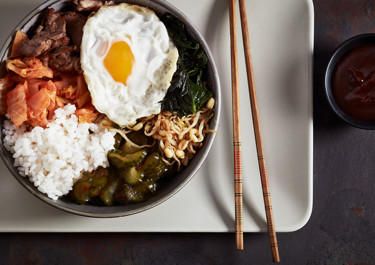&format=webp)
Bibimbap

Instructions
Marinated sirloin
Marinated spinach
Marinated bean sprouts
Chilli-pickled cucumber
For serving
The best drinks for bibimbap
From a wine perspective, pair your dinner with a full-bodied and slightly sweet Riesling. If you prefer to keep it traditional, serve with a Korean beer or makkoli, a lightly sparkling and opaque wine made from fermented rice and wheat.
Questions about bibimbap
Ingredients
Marinated meat
Sirloin steaks, thinly sliced | 400 g |
|---|---|
Japanese soya sauce | 2 tbsp |
Icing sugar | 1 tbsp |
Garlic cloves | 2 |
Sesame oil | 1 tbsp |
Marinated spinach
Baby spinach | 65 g |
|---|---|
Green onions | 3 |
Japanese soya sauce | 1 tbsp |
Sesame oil | 1 tbsp |
Sesame seeds | 1 tbsp |
Marinated bean sprouts
Bean sprouts | 150 g |
|---|---|
Fresh coriander | 1 handful |
Salt | 1 tsp |
Sesame seeds | 1 tbsp |
Sesame oil | 1 tbsp |
Chilli-pickled cucumber
Cucumber | 1 |
|---|---|
Icing sugar | 25 g |
Vinegar (12%) | ¼ dl |
Sambal oelek | 1 tbsp |
Serve with
Short-grain Rice | 250 g |
|---|---|
Butter and rapeseed oil | 2 tbsp |
Kimchi | 200 ml |
Eggs | 4 |
Gochujang | 4 tbsp |
A Korean street food staple
While the exact origin of bibimbap is unknown, reference to the dish can be found as far back as the 1500s. Today, it is one of Korea's most celebrated dishes with strong cultural roots and can be found in many restaurants, home kitchens and street corners across the country. Its global popularity is partly thanks to Korean Air when it included bibimbap on its in-flight menu in 1997.
The philosophy behind bibimbap
Said to symbolise harmony and balance, this dish is apparently a combination of the five colours of health: the dark ingredients pays homage to the north and foods that benefit the kidneys. Red and orange welcomes the south to the bowl and focuses on heart health. Green is for the east and optimal liver function. White represents the west and strong lungs, while the yellow egg serves as the centre and promotes a healthy stomach.
Spice it up or veg it out
Adding extra spice to your bibimbap is as easy as spooning extra gochujang into your bowl. Fresh chillies will also add an extra kick to your meal, as will a dash of Korean chilli oil. Swapping the meat for marinated mushrooms is also highly recommended and a great vegetarian option that will convert even the most devoted carnivore.










